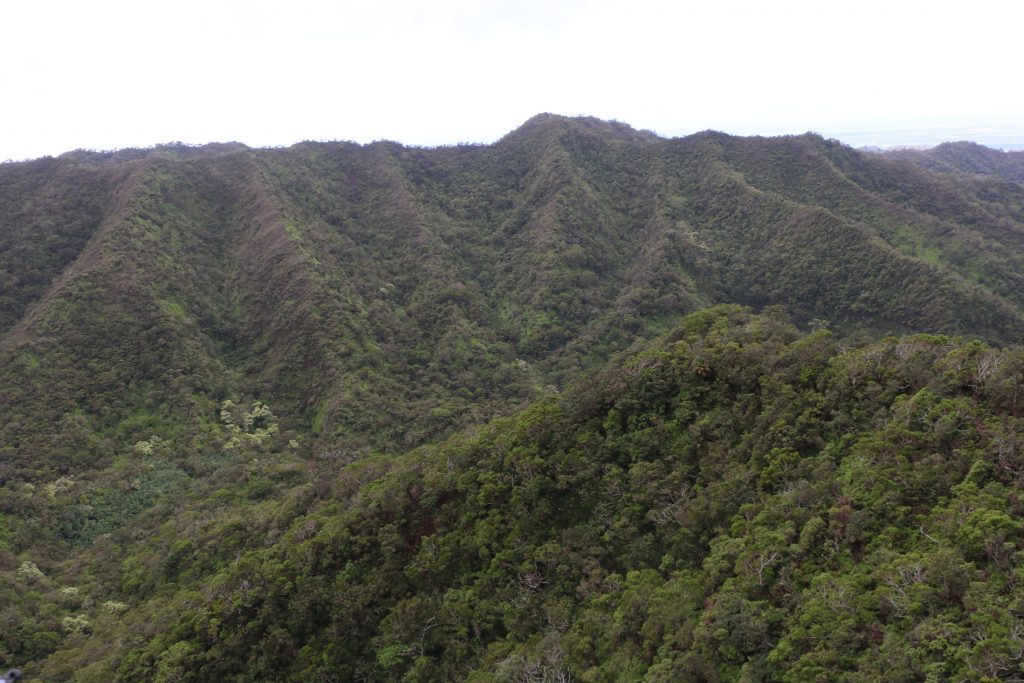06/16/22 – NEARLY $15 MILLION TO PROTECT THE WAIAWA WATERSHED AWARDED TO STATE OF HAWAI’I IN PARTNERSHIP WITH THE U.S. NAVY
Posted on Jun 16, 2022 in Commission On Water Resources Management, News Releases, slider| DAVID Y. IGE GOVERNOR |
SUZANNE D. CASE
CHAIRPERSON |
For Immediate News Release: June 16, 2022
NEARLY $15 MILLION TO PROTECT THE WAIAWA WATERSHED AWARDED TO STATE OF HAWAII IN PARTNERSHIP WITH THE U.S. NAVY
To view video please click on photo or view at this link: https://vimeo.com/manage/videos/211601335
(HONOLULU) – State of Hawai‘i, in partnership with Joint Base Pearl Harbor Hickam (JBPHH), met the challenge and is receiving $14,881,880 from the Department of Defense’s (DoD) Readiness and Environmental Integration Program (REPI), to help safeguard Oahu’s drinking water supplies.
Awarded under the REPI Challenge Program, funding will be dedicated to protecting and restoring native forests that replenish the Pearl Harbor Aquifer and provides long-term protection in the Ko‘olau Mountains.
Department of Land and Natural Resources Chair Suzanne Case said, “Upland forest protection is identified in the Navy’s Red Hill recovery and monitoring plan, so we appreciate the Navy’s advocacy to obtain funding of this critical project. The native forests are the source of drinking water for Navy personnel at JBPHH and protection of the watershed also provides a buffer from major storm events that can cause erosion and flooding. These Ko’olau forests are an enormous asset – yet they are disappearing due to feral pig damage and invasive weeds.”
“This project helps to ensure long term operations of Navy mission by targeting land conservation within areas that are critical to the supply and quality of water to our installations as well as areas where DoD employees and their families live, go to school, work and recreate,” said Capt. Randall Harmeyer, Public Works Officer for JBPHH. “By safeguarding the native forests, we improve both water quality and quantity.”
Research led by Dr. Leah Bremer (UH Economic Research Organization and Water Resources Research Center) demonstrated the importance of protecting native forest for groundwater supplies. “If we lose our forests, our water will have to come from more expensive pumping and even desalination projects. In the Pearl Harbor aquifer, full forest protection (~20,000 acres) saves the water utility $26 to $39 million per year (after 50 years) in replacement costs. Protecting our forest is not only good for the environment, but also provides important economic benefits.”
The funding provides support for numerous projects:
- Watershed fences to exclude feral pigs
- Ongoing fence management and weed control
- Miconia invasive plant survey and treatment
- Coconut Rhinoceros Beetle surveys and control
- Strawberry guava biocontrol
- Common and rare species out planting
- Makiki Baseyard improvements
- Waimano Baseyard improvements
Katie Roth, a planner with the Commission on Water Resource Management (CWRM) said, “In the long term, preventing portions of the forest from being converted to invasive plants and bare ground will increase filtration rates 15 times faster, according to a 2018 study. As our native forests quickly absorb rain, they dramatically reduce erosion and potential flooding at JBPHH, will benefit coral reefs, native stream animals, and critical habitat for 10 endangered plant species.”
“This is a major step toward fulfilling the Navy’s commitment to help with aquifer recovery and contribute to the State’s goal of protecting 30% of critical watershed forests by 2030,” said CWRM First Deputy Kaleo Manuel. “Hahai ka ua i ka ulu la‘au is a known kanaka strategy for water management and resiliency. This is yet another investment in the protection of our forests and the benefits that flow from them,” he explained.
Harmeyer stressed that since potable water found in Oahu’s many underground water sources combine to provide water to the entire island, these watershed protection actions will ultimately benefit every resident of Oahu, not solely those who live or work on Department of Defense installations. “Protection of the forests above JBPHH helps ensure there will be aquifer replenishment in the future not just for Pearl Harbor/Hickam, but also for much of Oahu’s residents,” added Harmeyer.
A fencing project in the Waiawa area of the Ewa Forest Reserve is in the process of enclosing 1,400 acres of land to protect it from feral ungulates. The Honolulu Board of Water Supply and Coca-Cola have also provided funding for this project because it protects future ground water resources.
In addition to the public and non-government organization support for watershed protection across O‘ahu, private companies such as Coca-Cola have been involved in donating money and volunteer labor in the Waiawa area.
The Ko‘olau Mountains Watershed Partnership, a unit of the University of Hawai‘i Pacific Cooperative Studies Unit coordinates protection of native forests on O‘ahu as a voluntary alliance of 19 public and private landowners, including DLNR and Kamehameha Schools.
# # #
RESOURCES
(All images/video courtesy: DLNR)
HD video – Ko‘olau Mountains/Coke watershed partnership (April 4, 2017):
https://vimeo.com/manage/videos/211601335
HD video – Waiawa watershed Coca-Cola volunteer day (Dec. 5, 2017):
https://vimeo.com/246029341
Media Contact:
Dan Dennison
Senior Communications Manager
[email protected]
